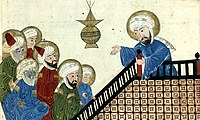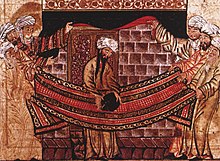| Revision as of 13:42, 28 February 2007 editALM scientist (talk | contribs)Extended confirmed users, Pending changes reviewers7,390 edits removed (PBUH)← Previous edit | Revision as of 13:48, 28 February 2007 edit undoH (talk | contribs)23,582 edits rv, You have not establish your argument of due weight with consensus, please don't just unilaterally make changes like this. Add calligraphy, but don't remove/move images against consensusNext edit → | ||
| Line 6: | Line 6: | ||
| Edit image details between this line --> | Edit image details between this line --> | ||
| ].{{Ed right2|Muhammad/images|section=1}}]] | ].{{Ed right2|Muhammad/images|section=1}}]] | ||
| ] entitled, "al-âthâr al-bâqiya" by ] (973-1048) held by the ]. Though depictions of Muhammad are culturally important, no undisputed record exists of his actual appearance{{Fact|date=February 2007}}.{{Ed right2|Muhammad/images|section=1}}]] | |||
| ] (16th century) Beautiful fresco painting with floral designs surrounding the words "Allah" and "Muhammad" in blue. Inscribed inside the names are calligraphic verses from the Quran in white paint of which the one inside the word "Allah" is the Ayat-ul-Kursi and the one inscribed inside the word "Muhammad" affirms the finality of Prophethood with the Prophet Muhammad.]] | |||
| <!-- and this line --> | <!-- and this line --> | ||
| <includeonly>}}</includeonly><!-- | <includeonly>}}</includeonly><!-- | ||
Revision as of 13:48, 28 February 2007
Image(s) 1

Image(s) 2
Image(s) 3
